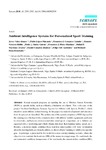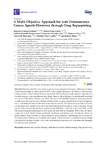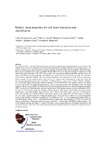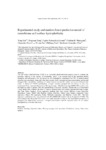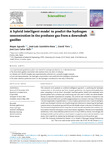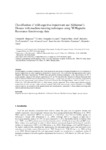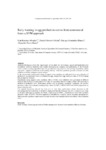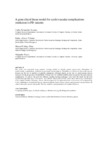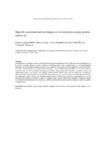Buscar
Mostrando ítems 1-10 de 117
Ambient Intelligence Systems for Personalized Sport Training
(Molecular Diversity Preservation International, 2010)
Several research programs are tackling the use of Wireless Sensor Networks (WSN) at specific fields, such as e-Health, e-Inclusion or e-Sport. This is the case of the project “Ambient Intelligence Systems Support for ...
A Multi-Objective Approach for Anti-Osteosarcoma Cancer Agents Discovery through Drug Repurposing
(MDPI AG, 2020-11-22)
[Abstract]
Osteosarcoma is the most common type of primary malignant bone tumor. Although nowadays 5-year survival rates can reach up to 60–70%, acute complications and late effects of osteosarcoma therapy are two of the ...
Markov Mean Properties for Cell Death-Related Protein Classification
(Elsevier, 2014-01-31)
[Abstract] The cell death (CD) is a dynamic biological function involved in physiological and pathological processes. Due to the complexity of CD, there is a demand for fast theoretical methods that can help to find new ...
Experimental study and random forest prediction model of microbiome cell surface hydrophobicity
(Elsevier, 2016-11-09)
[Abstract] The cell surface hydrophobicity (CSH) is an assessable physicochemical property used to evaluate the microbial adhesion to the surface of biomaterials, which is an essential step in the microbial biofilm formation ...
A hybrid intelligent model to predict the hydrogen concentration in the producer gas from a downdraft gasifier
(Elsevier, 2022-06-05)
[Abstract] This research work presents an artificial intelligence approach to predicting the hydrogen concentration in the producer gas from biomass gasification. An experimental gasification plant consisting of an air-blown ...
Classification of mild cognitive impairment and Alzheimer’s Disease with machine-learning techniques using 1H Magnetic Resonance Spectroscopy data
(Elsevier, 2015-03-30)
[Abstract] Several magnetic resonance techniques have been proposed as non-invasive imaging biomarkers for the evaluation of disease progression and early diagnosis of Alzheimer’s Disease (AD). This work is the first ...
Early Warning in Egg Production Curves from Commercial Hens: a SVM Approach
(Elsevier, 2016-01-02)
[Abstract] Artificial Intelligence allows the improvement of our daily life, for instance, speech and handwritten text recognition, real time translation and weather forecasting are common used applications. In the livestock ...
A generalized linear model for cardiovascular complications prediction in PD patients
(ACM, 2018)
[Abstract] This study was conducted using machine learning models to identify patient non-invasive information for cardiovascular complications prediction in peritoneal dialysis patients. Nowadays is well known that ...
Using Artificial Vision Techniques for Individual Player Tracking in Sport Events
(M D P I AG, 2019-07-31)
[Abstract] We introduce a hybrid approach that can track an individual football player in a video sequence. This solution achieves a good balance between speed and accuracy, combining traditional object tracking techniques ...
Applied Computational Techniques on Schizophrenia Using Genetic Mutations
(Bentham, 2013-03-01)
[Abstract] Schizophrenia is a complex disease, with both genetic and environmental influence. Machine learning techniques can be used to associate different genetic variations at different genes with a (schizophrenic or ...


